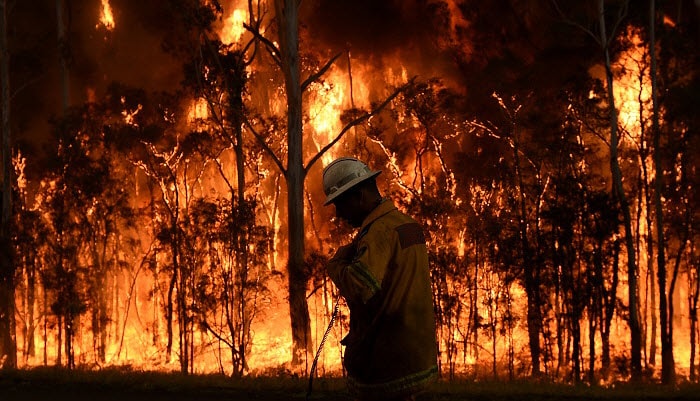The Value of Bushfire Administration in Fire Protection
In the realm of fire protection, the importance of effective bushfire management can not be understated. As communities worldwide face increasing instances of wildfires, the positive technique to avoiding and minimizing these all-natural catastrophes with tactical bushfire management strategies has actually become a critical component. Past the instant risk to human life and residential or commercial property, the interaction in between bushfire monitoring and environmental preservation, area participation, and climate change postures complicated challenges that need detailed services.
Importance of Proactive Bushfire Avoidance
Aggressive bushfire avoidance approaches are essential in reducing the ravaging influences of wildfires on environments and areas. By taking preventative procedures prior to a bushfire takes place, the dangers associated with these natural catastrophes can be dramatically lowered. One key element of aggressive bushfire prevention is gas administration. This involves reducing the quantity of flammable product, such as dead plants and completely dry leaves, that can serve as gas for fires. Fuel monitoring strategies consist of prescribed burns, where regulated fires are intentionally lit to minimize the build-up of flammable material.
Enlightening the public on fire security methods and advertising community recognition regarding the importance of bushfire avoidance are crucial components of aggressive approaches. Eventually, proactive bushfire avoidance plays a considerable role in guarding neighborhoods and communities from the damaging impacts of wildfires.
Role of Community Interaction in Fire Protection
Involving the neighborhood in fire protection initiatives is important to boosting the performance of positive bushfire prevention techniques. Area interaction plays an essential duty in cultivating a cumulative understanding of the threats posed by bushfires and the relevance of readiness measures. By entailing regional residents, authorities can share crucial info on fire safety methods, emptying procedures, and early caution systems, encouraging people to take proactive steps to safeguard their lives and residential properties.
By cultivating a culture of preparedness and collaboration, communities can reinforce their capacity to respond efficiently to bushfire emergencies, reducing the effect on lives and homes. Eventually, neighborhood interaction is a keystone of comprehensive fire protection strategies, stressing the importance of collective action in securing susceptible locations from the threat of bushfires.
Importance of Wild Animals Conservation in Bushfire Monitoring
Preservation of wild animals plays a crucial duty in efficient bushfire monitoring methods, making sure the defense of varied communities and biodiversity in fire-prone regions. Wild animals conservation is vital as it adds to the total strength of ecosystems, aiding in their ability to withstand and recoup from the impact of bushfires. By preserving environments and shielding various types, the all-natural equilibrium within these ecosystems is preserved, which is essential for their long-term health and sustainability.
Additionally, wild animals conservation additionally aids in lowering the risk and intensity of bushfires. Healthy and balanced ecosystems with unspoiled wildlife populaces can act as natural firebreaks, reducing down the spread of fires and limiting their damaging possibility (BAL Report). Certain pet types, like tunneling pets or birds that spread out seeds, play distinct roles in assisting or protecting against fires in the post-fire regeneration of habitats
Integrating wildlife conservation into bushfire monitoring strategies is not only crucial for safeguarding biodiversity but also for promoting the overall health and resilience of communities his comment is here when faced with raising fire hazards.
Benefits of Strategic Gas Decrease Programs
Strategically executing gas decrease programs is important in minimizing the risk and effect of bushfires in fire-prone areas. These programs involve regulated burning, mechanical cleaning, and various other techniques to lower the quantity of flammable plants available to fuel wildfires. By tactically minimizing fuel loads in key locations, such as close to residential communities or critical infrastructure, the strength and spread of bushfires can be considerably reduced.
One of the primary benefits of gas reduction programs is the enhancement of total fire durability in an ecological community. By producing critical gas breaks and lowering the continuity of greenery, these programs help to disrupt the path of a bushfire, making it easier for firemans to contain and snuff out the blaze. Furthermore, gas reduction programs can secure biodiversity by avoiding exceedingly extreme fires that can ravage environments and threaten wildlife populaces.
Additionally, these programs can additionally protect human lives and building by reducing the threat of disastrous fires that present a considerable danger to areas. Eventually, critical gas reduction programs play an essential duty in proactive bushfire administration and promoting a more secure environment for both people and nature.
Effect of Environment Change on Bushfire Danger

Higher temperature levels lead to drier plants, making it more prone to ignition. Reduced rainfall in particular regions lengthens dry spell conditions, better boosting the flammability of the landscape. Furthermore, the transforming environment has actually altered wind patterns and climatic problems, leading to more erratic fire behavior and rapid fire spread.
As the environment remains to alter, the regularity and strength of bushfires are anticipated to rise, demanding a positive and flexible method to bushfire monitoring. Methods should progress to represent the transforming threat landscape, incorporating climate forecasts and taking into consideration lasting resilience in fire management planning. Attending to the influence of climate modification on bushfire threat is critical in creating reliable techniques to secure lives, residential or commercial property, and the environment.
Conclusion
In final thought, positive bushfire avoidance, neighborhood involvement, wildlife preservation, strategic gas reduction programs, and consideration of environment modification are essential elements in effective fire security. By applying these strategies, we can better take care of bushfire dangers and secure both human lives and the atmosphere. BMP. It is vital that stakeholders collaborate to prioritize these actions to decrease the damaging influence of bushfires on areas and ecological communities

As the environment proceeds to transform, the regularity and strength visit their website of bushfires are anticipated to climb, necessitating a adaptive and positive method to bushfire monitoring.In final thought, positive bushfire prevention, neighborhood interaction, wildlife preservation, critical gas decrease programs, and consideration of climate change are essential components in effective fire defense.